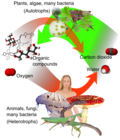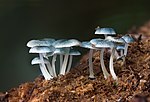 | Saprotrophic nutrition /sæprəˈtrɒfɪk, -proʊ-/ or lysotrophic nutrition is a process of chemoheterotrophic extracellular digestion involved in the processing... 7 KB (757 words) - 19:02, 17 March 2024 |
Saprotrophic bacteria are bacteria that are typically soil-dwelling and utilize saprotrophic nutrition as their primary energy source. They are often associated... 13 KB (1,510 words) - 23:31, 26 February 2024 |
photosynthesis to produce their own food from sunlight. Some fungi may be saprotrophic, meaning they will extracellularly secrete enzymes onto their food to... 3 KB (216 words) - 02:09, 20 October 2023 |
 | Detritivore (category Microbial growth and nutrition) decomposers live by absorbing and metabolizing on a molecular scale (saprotrophic nutrition). The terms detritivore and decomposer are often used interchangeably... 10 KB (980 words) - 02:51, 17 March 2024 |
externally and then absorb the products. This process is called saprotrophic nutrition. Fungi are examples of saprobiontic organisms, which are a type... 2 KB (186 words) - 18:46, 9 February 2024 |
and minerals are absorbed; here the digestion is intracellular. Saprotrophic nutrition Advanced Biology Principles, p296, fig 14.16—Diagram detailing the... 14 KB (1,800 words) - 15:34, 8 April 2024 |
 | Mineral (nutrient) (redirect from Mineral (nutrition)) In the context of nutrition, a mineral is a chemical element. Some "minerals" are essential for life, most are not. Minerals are one of the four groups... 37 KB (3,054 words) - 16:35, 22 March 2024 |
M N O P Q R S T U V W X Y Z See also References External links saprotrophic nutrition savanna A tropical or subtropical grassland ecosystem with trees... 56 KB (6,059 words) - 06:56, 23 February 2024 |
decomposer, i.e. any organism feeding on dead organic matter (see Saprotrophic nutrition) This disambiguation page lists articles associated with the title... 226 bytes (56 words) - 12:44, 30 June 2011 |
internal nutrition, as well as the main two types of fungi that are most often referred to, as well as describes, visually, the process of saprotrophic nutrition... 137 KB (14,804 words) - 14:17, 19 April 2024 |
Holopogon pekinensis is a kind of saprotrophic nutrition orchid. In 2017 it was found in Beijing. It grows under a wooded forest in a ravine at an altitude... 5 KB (599 words) - 18:31, 11 December 2023 |
 | now termed myco-heterotrophs. Necrophage Detritivore Decomposer Saprotrophic nutrition Consumer-resource systems Getz, W. (2011). Biomass transformation... 2 KB (229 words) - 20:54, 5 October 2021 |
 | February 2017. Miles PG; Chang S-T. (2004). Mushrooms: Cultivation, Nutritional Value, Medicinal Effect, and Environmental Impact. CRC Press. p. 241... 16 KB (1,435 words) - 15:22, 2 April 2024 |
 | Agaricus bisporus (section Nutrition) United States Food and Drug Administration (2024). "Daily Value on the Nutrition and Supplement Facts Labels". Retrieved 28 March 2024. National Academies... 17 KB (1,654 words) - 04:41, 16 April 2024 |
 | "fungus", ἕτερος heteros, "another", "different" and τροφή trophe, "nutrition") is a symbiotic relationship between certain kinds of plants and fungi... 16 KB (1,531 words) - 19:18, 8 November 2023 |
 | Flammulina filiformis (section Nutritional profile) United States Food and Drug Administration (2024). "Daily Value on the Nutrition and Supplement Facts Labels". Retrieved 2024-03-28. National Academies... 9 KB (857 words) - 05:17, 26 March 2024 |
 | sedentary), feeding behaviour and mechanisms, nutrition mode (free-living, parasitic, holozoic, saprotrophic, trophic type), type of habitat (terrestrial... 6 KB (644 words) - 09:50, 13 December 2023 |
 | Volvariella volvacea (section Nutrition) 19th century. One cup (182 grams or 6.4 ounces) of straw mushrooms is nutritionally dense and provides 240 kilojoules (58 kilocalories) of food energy,... 5 KB (453 words) - 15:09, 11 April 2024 |
 | United States Food and Drug Administration (2024). "Daily Value on the Nutrition and Supplement Facts Labels". Retrieved 2024-03-28. National Academies... 7 KB (931 words) - 07:41, 31 March 2024 |
 | the Western Cape, South Africa. Neolentinus lepideus has a saprotrophic mode of nutrition and is an important woodland decomposer and a cause of wet rot... 7 KB (634 words) - 17:02, 16 January 2024 |










